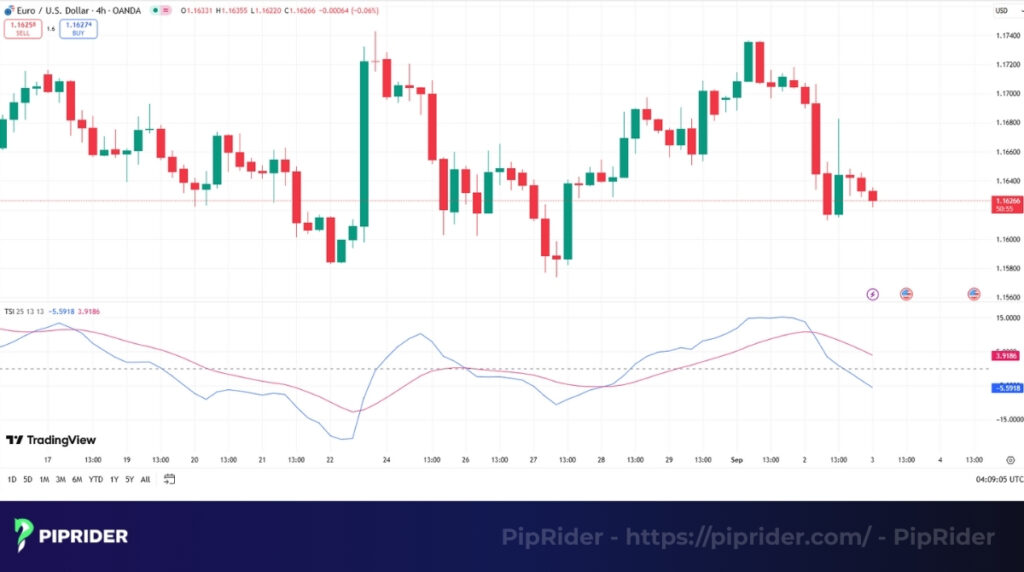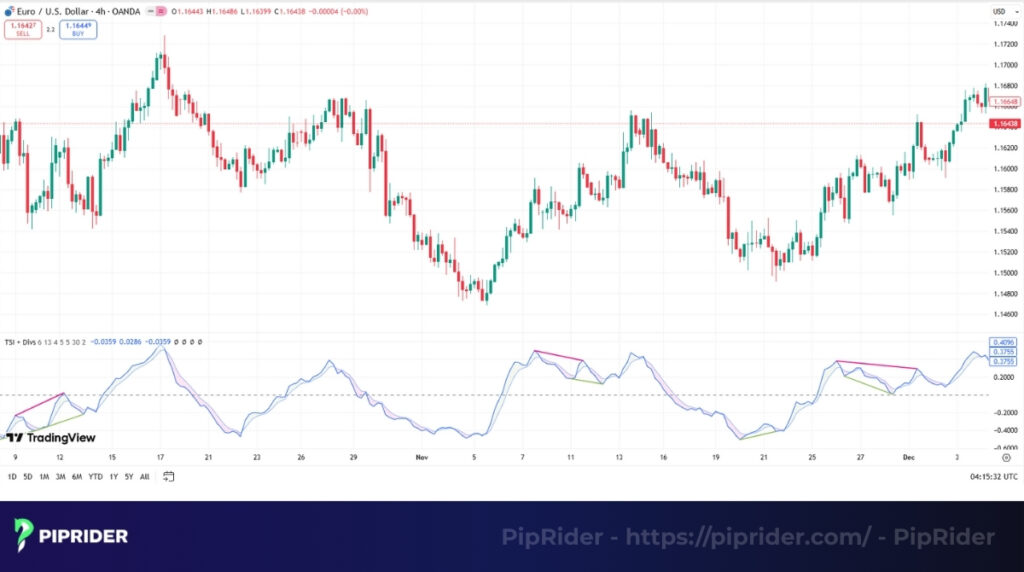Many traders face challenges with complex indicators and charts cluttered by choppy, misleading signals. The True Strength Index TSI solves this by using a unique “double smoothed” approach designed specifically to filter out market noise. This provides a clearer, more accurate representation of a trend’s true strength and direction.
Piprider will provide a practical methodology for using the TSI, covering its application in trend identification, risk management, and spotting high-probability reversal opportunities.
Key Takeaways
- The True Strength Index (TSI) is a smoothed oscillator that reveals a trend’s true momentum.
- Its unique formula uses a double smoothed calculation to effectively filter out erratic price noise.
- Read the TSI chart by identifying crossovers, divergences, and key overbought/oversold levels.
- Use this indicator to confirm trends, trade powerful reversals, and validate breakouts.
- The TSI often provides clearer and less frequent trading signals compared to the RSI or MACD.
1. What Is the True Strength Index TSI?
1.1. Definition
True Strength Index TSI is a technical momentum oscillator that gauges the strength and direction of a market trend (StockCharts, n.d.). Its primary objective is to provide a clear, smoothed representation of price momentum by measuring the velocity of price changes. What makes the indicator unique in technical analysis is its method of double smoothing these price changes, which helps to filter out insignificant market noise.

In the 1990s, William Blau engineered the TSI to blend the responsiveness of a momentum indicator with the stability of moving averages. This creates a versatile tool that traders find highly effective across various financial markets (Investopedia, 2005).
Here is how traders typically apply the TSI:
- Stocks: Traders apply it to confirm the strength of a stock price move following major news or earnings.
- Forex: It filters noise during quiet periods and highlights true momentum when major market sessions overlap.
- Crypto: Its smoothing feature is essential for separating sustainable trends from brief, volatile spikes.
1.2. Components
The TSI is constructed from three primary components that work together to produce the final indicator.
- Price Momentum Line (PML): This measures raw market momentum, calculated as the difference between the current and previous closing prices.
- Volatility Smoothing: This core mechanism applies a double Exponential Moving Average to the PML. This smoothing technique effectively smooths the data to filter out market noise.
- Signal Line: This is an EMA of the final, smoothed TSI line. We use its crossovers to identify potential trading signals.
Read more:
Directional Movement Indicator (DMI): Definition & Strategies
2. How to Calculate the True Strength Index TSI?
While modern trading platforms calculate the TSI for us automatically, understanding the calculation behind the formula helps traders appreciate why it is so effective at filtering out market noise. The calculation involves a multi-step process designed to smooth raw price data.
The core formula is as follows:
TSI = 100 × (Double Smoothed PC / Double Smoothed Absolute PC)
Let’s break down each component:
- Price Change (PC): As the indicator’s most basic input, this value represents the difference between the current close and that of the previous period.
PC = Current Close – Prior Close
- Absolute PC: This represents the non-negative value of the Price Change for the period.
- Smoothing Periods (EMAs): The crucial step is the double-smoothing process, which uses two sequential Exponential Moving Averages (EMAs). The process begins by applying a long-period EMA (typically 25 periods) to both the PC and the absolute price change. The result is then smoothed a second time with a short-period EMA (typically 13 periods).
This two-step smoothing process is what provides the TSI with its characteristic low volatility and smooth visual appearance.
A Simple Example with a TSI Stock Price
For instance, if a stock closes at $152 today versus $150 yesterday, its Price Change (PC) is +$2. The absolute value is also $2. The TSI then processes these daily values over time, applying 25-period and 13-period EMAs. This process creates the final, smooth TSI line seen on a chart.
Read more:
Forex Trading 2025: Unleash DeMarker Indicator’s (DeM) Power
3. Interpreting the True Strength Index TSI Values
The correct interpretation of the True Strength Index indicator is straightforward. We focus on three key signals: extreme levels, line crossovers, and price divergence, which often foreshadow significant market turns.
3.1. Overbought and Oversold Levels (+25 / -25)

These levels act as warning zones when a trend might be overextended.
- Above +25: Suggests strong buying pressure that might soon run out of steam, potentially leading to a price drop.
- Below -25: Suggests strong selling pressure that could be nearing exhaustion, potentially leading to a price bounce.
Pro tip: Use these levels to manage existing trades (e.g., tighten stop-losses), not as standalone signals to open new ones. An asset can remain in this extreme zone for a long time.
3.2. Centerline & Signal Line Crossovers
Crossovers signal a potential shift in market momentum.
- Centerline Cross: When the TSI crosses above zero, momentum turns bullish. When it crosses below zero, momentum turns bearish. This is a primary trend direction signal.
- Signal Line Cross: A faster, earlier signal occurs when the TSI line crosses its companion EMA. This can be used for more aggressive trade entries.
3.3. Divergence Between TSI And Price

The True Strength Index TSI and Price Divergence is a powerful reversal signal that occurs when the indicator and the price move in opposite directions. Spotting this disagreement is a key skill for anticipating a potential price reversal.
- Negative Divergence: The price makes a higher high, but the TSI makes a lower high. This warns that buying momentum is weakening.
- Positive Divergence: The price makes a lower low, but the TSI makes a higher low. This warns that selling momentum is fading.
4. Trading Strategies Using The True Strength Index
Knowing how to read the True Strength Index TSI is one thing; applying it to a live trade is another. Piprider introduce the way to use the TSI in three primary strategies, each suited for different market conditions.
4.1. Trend Confirmation Strategy
Trend confirmation is a lower-risk approach that involves joining an established trend after a pullback. The process requires identifying the trend on the chart and waiting for a price retreat. Entry is then timed when the TSI confirms momentum is re-aligning with the dominant trend, such as the TSI line crossing back above its companion EMA during an uptrend dip.
4.2. Reversal Trading Strategy
Reversel trading strategy uses divergence to anticipate trend reversals. A positive divergence (price lower lows, TSI higher lows) suggests selling pressure is weakening. Trades are only considered after the chart validates the signal, typically through a reversal candle pattern or a break of a key trend line.
4.3. Breakout Entry
The TSI is an excellent tool for filtering out false breakouts, which are common market traps. When the price breaks key support or resistance, the TSI is used for confirmation. A valid breakout must be supported by strong, corresponding momentum in the indicator. If the price breaks out but the TSI is flat, weak, or opposing the move, the event is identified as a high-risk “false breakout” and is typically avoided.
5. Practical Applications Of The True Strength Index TSI
Beyond specific strategies, the TSI has three core functions that make it a valuable part of a daily trading process:
- Trend Confirmation: A primary application is to confirm the strength of a trend. A healthy uptrend should be accompanied by rising TSI values. A falling TSI during an uptrend can warn that the move is losing momentum.
- Trade Entry and Exit Signals: The indicator generates clear signals for timing trades. A trader might enter a long position on a bullish centerline crossover or exit a position when a bearish divergence warns of a potential reversal.
- Risk Management: The TSI also serves as a proactive risk management tool. By identifying weakening momentum or potential reversals, traders can adjust stop-loss orders or reduce position sizes accordingly to protect capital.
6. Example Scanners And Trade Setups With TSI
Automating the search for high-quality setups is a key part of efficient trading. The TSI is well-suited for use in market scanners and automated alerts.
6.1. Scanning for TSI Signal Line Crosses
Most trading platforms allow traders to build custom scans to find assets that meet specific criteria. A simple yet effective scan is to look for a TSI crossover, which can indicate the start of a new momentum move.
- Bullish Scan: The condition would be “The TSI Line crosses above its companion EMA.” This helps find stocks or forex pairs where momentum is just starting to turn positive.
- Bearish Scan: The condition would be “The TSI Line crosses below its companion EMA.” This is useful for identifying assets where momentum is shifting to the downside.
6.2. Setting Up Alerts on TradingView & TrendSpider

Manually watching charts all day is not practical. Setting up alerts is far more efficient.
- On TradingView: Select the asset, open the “Alerts” panel, and set the “Condition” to the TSI indicator. Traders can then create an alert for when the TSI crosses its companion EMA, the Zero Line, or even a specific value like +25.
- On TrendSpider: This platform excels at multi-factor alerts. A trader could create a more robust alert that only triggers if the TSI crosses its companion EMA and the price is above a key moving average at the same time.
6.3. Case Study: A High-Probability Setup (TSI + Volume + EMA Filter)
Confluence is when multiple indicators provide the same signal, increasing the probability of a successful trade. Here is a classic setup that combines the True Strength Index TSI with other tools.

Let’s imagine a stock is in a long-term uptrend, confirmed by its price trading above the 50-period EMA. A trader spots a positive divergence on the TSI during a price pullback, suggesting the downtrend is losing steam.
The entry is not taken on the divergence alone. Instead, the trader waits for the price to break above a short-term resistance level. The final confirmation is that this breakout occurs on higher-than-average volume (ideally confirmed by the best volume indicator for forex trading). At the same time, the TSI crosses above its signal line.
This combination of a long-term trend filter (EMA), momentum signal (TSI), and volume confirmation creates a robust, high-probability trade setup.
7. Comparing TSI with Other Momentum Oscillators
No single indicator is perfect for all conditions, and it’s important to understand the nuances of different oscillator signals. Choosing the right tool depends on the market environment and your trading style. The table below provides a concise comparison of the most popular momentum oscillators.
| Indicator | Advantages (Pros) | Disadvantages (Cons) | Best Use Case |
| True Strength Index (TSI) | Very smooth; filters out market noise Fewer incorrect signals in trending markets | Slower to react to sharp, sudden price changes | Identifying momentum in trending markets |
| Relative Strength Index (RSI) | Simple for spotting divergence Effective for overbought/oversold levels | Can be choppy and give false signals Stays extreme in strong trends | Gauging overbought/oversold in moderately trending or range-bound markets |
| MACD | Defines the primary trend’s direction Histogram visualizes momentum shifts | It is a lagging indicator by design Prone to whipsaws in sideways markets | Confirming the strength and direction of a long-term trend |
| Stochastic Oscillator | Very fast and responsive to price Excellent for signals in ranges | Extremely “noisy” and erratic in trends Causes many misleading entries | Trading reversals in range-bound, sideways markets |
8. Frequently asked questions about the True Strength Index TSI
9. Summary
Mastering the True Strength Index TSI is not about memorizing a complex calculation but about understanding its role as a powerful momentum filter. By interpreting its centerline crossovers, divergence signals, and overbought/oversold levels, traders can gain a significant edge in identifying trend strength and potential reversals.
The TSI is a fantastic tool, but it’s just one piece of a complete trading system. To build a robust strategy, it’s essential to understand how other tools work. We encourage you to continue your learning journey by exploring our Best Technical Indicators in the Learn Forex category on Piprider.








